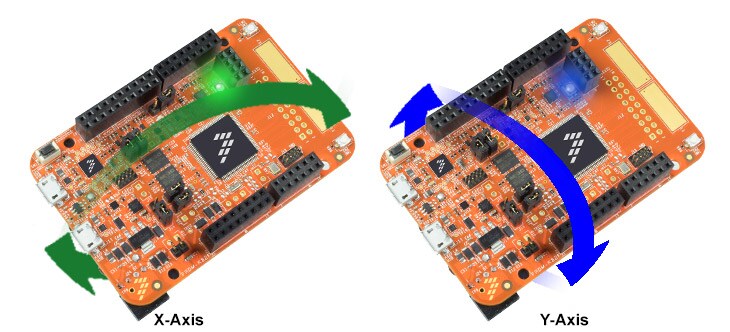FRDM-K82Fのスタート・ガイド
このドキュメントの内容
-
接続
-
ソフトウェアの入手
-
ビルドと実行
-
作成
サインイン 進行状況を保存するには アカウントをお持ちでない方 アカウントを作成する。

お客様の FRDM-K82F | K82/K81/K80 | Wireless
1. 接続
実際にFRDM-K82Fを使ってみましょう!ショート・ビデオで手順を視聴するか、以下に記載された詳細な手順を参考にして、作業を進めてください。
1.1 FRDM-K82F開発プラットフォームのスタート・ガイド
2. ソフトウェアの入手
2.1 FRDM-K82F用ソフトウェアをインストールする
2.2 Kinetis SDKですぐに設計を開始する
Kinetisソフトウェア開発キット (SDK) は無償で利用することができ、パーミッシブ型オープンソース・ライセンスに基づいて、すべてのハードウェア抽象化およびペリフェラル・ドライバ・ソフトウェアのソース・コード全体が提供されます。SDKの詳細はこちら。
下のボタンをクリックして、K82F SDKパッケージをダウンロードしてください。
2.3 ツールチェーンをインストールする
NXPでは、Kinetis Design Studio (KDS) というツールチェーンを無償で提供しています。

別のツールチェーンを使用したい場合は?
問題ありません。Kinetis SDKは、IAR 、Keil 、コマンドラインGCC などの他のツールをサポートしています。

2.4 PCの設定
サンプル・アプリケーションの多くは、マイクロコントローラのUARTを介してデータを出力します。ボードの仮想COMポート用ドライバがインストールされているか必ず確認してください。ドライバのインストーラを実行する前に、ボードをPCに接続しておく必要があります。
シリアル・ポート・ドライバをインストールした状態で、お好きなターミナル・アプリケーションを実行し、マイクロコントローラのUARTからのシリアル出力を確認します。ターミナルをボーレート115,200、8データ・ビット、パリティなし、1ストップ・ビットに設定します。FRDM-K82Fの仮想COMポートのポート番号を調べるには、デバイス・マネージャを開き、「Ports(ポート)」グループを確認します。
ターミナル・アプリケーションの使用方法がわからない場合は、Tera TermチュートリアルまたはPuTTYチュートリアルのいずれかのチュートリアルをお試しください。
3. ビルドと実行
3.1 FRDM-K82FでのSDKデモのビルドと実行
3.2 SDKサンプル・コードを確認する
Kinetis SDKには、サンプル・アプリケーション・コードが豊富に用意されています。利用可能なコードを確認するには、SDKをインストールしたフォルダのSDKボード・フォルダを参照し、FRDM-K82Fボード
特定のサンプル・コードの詳細については、サンプルのディレクトリにあるreadme.txtファイルを開いてください。
3.3 SDKサンプルのビルド、実行、およびデバッグ
興味のあるデモ・アプリケーションやドライバのサンプルがいくつかあれば、それをビルドおよびデバッグする方法を知りたくなることでしょう。Kinetis SDKのスタート・ガイドでは、SDKでサポートされているすべてのツールチェーンのデモを設定、ビルド、およびデバッグする方法について、わかりやすく手順に沿って解説しています。
Kinetis Design Studio (KDS) IDEを使用してサンプル・アプリケーションを開き、ビルドやデバッグを行う方法については、下記のガイドをご覧ください。
Kinetis Design Studio IDEを使用してデモを実行する
KSDKでKDS IDEを使用する前にツールが最新であるか確認することを推奨します。以下の手順はWindows版のKDSを使用して説明されていますが、MacユーザーとLinuxユーザーの場合も同じです。
- [Help(ヘルプ)]>[Check for Updates(アップデートの確認)]の順に選択します

- Freescale/NXPによるすべてのアップデートをインストールします。このようなアップデートには
com.NXP.xxxまたはcom.nxp.xxxと記載されています。ツールチェーンやデバッグ・インターフェースなどもアップデートされている場合があります。これらの追加のアップデートは通常はインストールしても問題ありませんが、KDSツールチェーンの一部としてリリースされてはいないため、場合によっては問題が発生することがあります
サンプル・アプリケーションのビルド
次の手順に従ってhello_worldアプリケーションを開きます。他のサンプル・アプリケーションでは、手順がわずかに異なる場合があります。アプリケーションによってはパスのフォルダ階層が深くなるためです。
- KDS IDEメニューから、[File(ファイル)]>[Import(インポート)]の順に選択します。表示されるウィンドウで、[General(全般)]フォルダを展開し、[Existing Project Sets(既存のプロジェクト・セット)]を選択します。[Next(次へ)]ボタンをクリックします

- [Select root directory:(ルート・ディレクトリを選択:)]オプションの横にある[Browse(参照)]ボタンをクリックします

-
適切なデバイスのプラットフォーム・ライブラリ・プロジェクトを指定します。このプロジェクトは次のパスで見つけることができます。
/boards/ / / /kds このガイドでは、次の特定の場所を選択します。
/boards/frdmk82f/demo_apps/hello_world/kds - 正しいディレクトリを指定すると、下の図のような[Import Working Sets and Projects(ワーキング・セットとプロジェクトをインポート)]ウィンドウが表示されます。[Finish(完了)]ボタンをクリックします

- 各KSDKプロジェクトに対して、以下の2つのプロジェクト設定(ビルド・ターゲット)がサポートされます。
- Debug(デバッグ):コンパイラ最適化は「低」に設定され、実行ファイルのデバッグ情報が生成されます。開発時やデバッグ時には、このターゲットを選択します
- Release(リリース):コンパイラ最適化は「高」に設定され、デバッグ情報は生成されません。最終的なアプリケーション実装時には、このターゲットを選択します
- 下の図に示すように、ハンマー・アイコンの横にある下向きの矢印をクリックして、[Debug(デバッグ)]または[Release(リリース)]のうち、適切なビルド・ターゲットを選択します。ここでは、[Debug(デバッグ)]ターゲットを選択します

- ビルド・ターゲットを選択すると、ライブラリのビルドが開始されます。今後、ライブラリをリビルドする際は、ハンマー・アイコンをクリックします(同じビルド・ターゲットを選択する場合)
サンプル・アプリケーションの実行
FRDM-K82Fボードには、工場出荷時にmbed/CMSIS-DAPデバッグ・インターフェースが搭載されています。現在のバージョンのKDSでは、K82でこのインターフェースがサポートされません。KDS IDEを使用してダウンロードやボードのデバッグを行うには、J-Link OpenSDA v2.1アプリケーションまたはP&E OpenSDA v2.1アプリケーションをインストールしておく必要があります。
JLink OpenSDA v2.1アプリケーションをFRDM-K82Fボードにインストールするには、次の手順に従ってください。
- ボードの電源を切った状態で、FRDM-K82Fの[Reset (リセット)]ボタンを押しながら、micro-B USBケーブルをボードの「SDA USB」USBポートに接続します
- [Reset(リセット)]ボタンを離します
- ボードが「ブートローダ」ドライバとして列挙されます
- JLink OpenSDA v2.1アプリケーション の.binファイルをこのドライブにドラッグ&ドロップします
- 電源を入れ直すと、ボードでJLink OpenSDAアプリケーションが実行されます
- J-Link OpenSDAアプリケーションがボードにロードされたら、PCのターミナル・アプリケーション(PuTTY、Tera Termなど)を開き、事前に確認したデバッグCOMポートに接続します。次の設定値を用いてターミナルを設定します。
- ボーレート115,200
- パリティなし
- 8データ・ビット
- 1ストップ・ビット
-
Linux OSユーザーの場合のみ。ターミナルで次のコマンドを実行します。これにより、システムに「libudev」がインストールされます。libudevは、KDS IDEでデバッガを起動する際に必要となります
user@ubuntu:~$ sudo apt-get install libudev-dev libudev1 user@ubuntu:~$ sudo ln -s /usr/lib/x86_64-linux-gnu/libudev.so /usr/lib/x86_64-linux-gnu/libudev.so.0 - 接続するターゲットに対して、デバッガが適切に設定されているか確認します。これは、ボードのOpenSDAインターフェースを指します。ボードの内容が不明な場合は、PDFの付録Bを参照してください
- 利用可能なデバッガ設定を確認するには、緑色の[Debug(デバッグ)]ボタンの横にある小さな下向きの矢印をクリックして、[Debug Configurations(デバッグ構成)]を選択します

- [Debug Configurations(デバッグ構成)]ダイアログ・ボックスで、使用しているハードウェア・プラットフォームに対応するデバッグ構成を選択します。今回の例では、「GDB SEGGER J-Link Debugging(GDB SEGGER J-Linkデバッグ)」カテゴリの下の「debug J-Link(J-Linkのデバッグ)」オプションを選択しています
- デバッガ・インターフェースを選択したら、[Debug(デバッグ)]ボタンをクリックしてデバッガを起動します

- 利用可能なデバッガ設定を確認するには、緑色の[Debug(デバッグ)]ボタンの横にある小さな下向きの矢印をクリックして、[Debug Configurations(デバッグ構成)]を選択します
- アプリケーションがターゲットにダウンロードされると、自動的にmain()が実行されます。

- [Resume(再開)]ボタンをクリックして、アプリケーションを起動します。

- hello_worldアプリケーションが実行され、ターミナルにバナーが表示されます。表示されない場合は、ターミナルの設定と接続を確認してください

別のツールチェーンを使用する場合:
IARを使用してデモを実行する
サンプル・アプリケーションのビルド
次の手順に従ってhello_worldアプリケーションを開きます。他のサンプル・アプリケーションでは、手順がわずかに異なる場合があります。アプリケーションによってはパスのフォルダ階層が深くなるためです。
-
目的のサンプル・アプリケーション・ワークスペースをまだ開いていない場合はここで開きます。ほとんどのサンプル・アプリケーション・ワークスペースのファイルは、次のパスに置かれています。
/boards/ / / /iar hello_worldデモをサンプルとして使用する場合、パスは次のようになります。
/boards/frdmk82f/demo_apps/hello_world/iar - ドロップダウン・リストから、目的のビルド・ターゲットを選択します。ここでは、「hello_world - Debug」ターゲットを選択します

- アプリケーションをビルドするには、下の図で赤色でハイライト表示されている[Make(作成)]ボタンをクリックします

- ビルドが正常に完了します
サンプル・アプリケーションの実行
FRDM-K82Fボードには、工場出荷時にmbed/CMSIS-DAPデバッグ・インターフェースが搭載されています。ボードのデバッグOpenSDAアプリケーションを変更している場合、OpenSDAにアクセスして、ボードを更新または工場出荷時の状態に復元する方法をご確認ください。
- 開発プラットフォームをPCに接続します。ボード上の「SDAUSB」USBポートとPCのUSBコネクタをUSBケーブルでつないでください
- PCのターミナル・アプリケーション(PuTTY、Tera Termなど)を開き、事前に確認したデバッグCOMポートに接続します。次の設定値を用いてターミナルを設定します。
- ボーレート115,200
- パリティなし
- 8データ・ビット
- 1ストップ・ビット
- [Download and Debug(ダウンロードとデバッグ)]ボタンをクリックして、アプリケーションをターゲットにダウンロードします

- アプリケーションがターゲットにダウンロードされると、自動的にmain()関数まで実行されます

- [Go(実行)]ボタンをクリックすると、コードが実行され、アプリケーションが起動します

- hello_worldアプリケーションが実行され、ターミナルにバナーが表示されます。表示されない場合は、ターミナルの設定と接続を確認してください

Keil® MDK/µVision®を使用してデモを実行する
CMSISデバイス・パックのインストール
MDKツールをインストールした後、デバッグ目的でデバイスを完全にサポートするには、CMSIS (Cortex® Microcontroller Software Interface Standard) デバイス・パックをインストールする必要があります。このパックには、メモリ・マップ情報、レジスタ定義、フラッシュ・プログラミング・アルゴリズムなどが含まれています。下記の手順に従って、適切なCMSISパックをインストールしてください。
- µVisionという名前のMDK IDEを開きます。IDEで[Pack Installer(パック・インストーラ)]アイコンを選択します

- [Pack Installer(パック・インストーラ)]ウィンドウで、Kinetisパックのセクションに移動します(アルファベット順に並んでいます)。Kinetisパックの名前は、「Keil::Kinetis」で始まり、MCUのファミリ名が続きます(「Keil::Kinetis_K80_DFP」など)。ここではFRDM-K82Fプラットフォームを使用するため、K80ファミリのパックを選択します。パックの横にある[Install(インストール)]ボタンをクリックします。このプロセスを正常に完了するには、インターネット接続が必要となります

- インストールが完了したら、[Pack Installer(パック・インストーラ)]ウィンドウを閉じて、µVision IDEに戻ります
サンプル・アプリケーションのビルド
次の手順に従ってhello_worldアプリケーションを開きます。他のサンプル・アプリケーションでは、手順がわずかに異なる場合があります。アプリケーションによってはパスのフォルダ階層が深くなるためです。
-
目的のデモ・アプリケーション・ワークスペースをまだ開いていない場合は以下で開きます。
/boards/ / / /mdk ワークスペース・ファイルの名前は、
.uvmpwです。今回の例の場合、実際のパスは次のようになります。 /boards/frdmk82f/demo_apps/hello_world/iar/hello_world.uvmpw - デモ・プロジェクトをビルドするには、赤色でハイライト表示されている[Rebuild(リビルド)]ボタンを選択します

- ビルドが正常に完了します
サンプル・アプリケーションの実行
FRDM-K82Fボードには、工場出荷時にmbed/CMSIS-DAPデバッグ・インターフェースが搭載されています。ボードのデバッグOpenSDAアプリケーションを変更している場合、OpenSDAにアクセスして、ボードを更新または工場出荷時の状態に復元する方法をご確認ください。
- 開発プラットフォームをPCに接続します。ボード上の「SDAUSB」USBポートとPCのUSBコネクタをUSBケーブルでつないでください
- PCのターミナル・アプリケーション(PuTTY、Tera Termなど)を開き、事前に確認したデバッグCOMポートに接続します。次の設定値を用いてターミナルを設定します。
- ボーレート115,200
- パリティなし
- 8データ・ビット
- 1ストップ・ビット
- アプリケーションが正しくビルドされたら、[Download(ダウンロード)]ボタンをクリックして、アプリケーションをターゲットにダウンロードします

- [Download(ダウンロード)]ボタンをクリックすると、アプリケーションがターゲットにダウンロードされ、自動的に実行されます。アプリケーションをデバッグする場合、赤色でハイライト表示されている[Start/Stop Debug Session(デバッグ・セッションの開始/終了)]ボタンをクリックします

- [Run(実行)]ボタンをクリックすると、コードが実行され、アプリケーションが起動します

- hello_worldアプリケーションが実行され、ターミナルにバナーが表示されます。表示されない場合は、ターミナルの設定と接続を確認してください

Arm® GCCを使用してデモを実行する
ツールチェーンのセットアップ
ここでは、Kinetis SDKでサポートされているように、Arm GCCツールチェーンを使用してKSDKデモ・アプリケーションのビルドと実行を行う際に必要となるコンポーネントをインストールする手順について説明します。
Arm GCCツールの使用方法はさまざまですが、今回の例では、Windows環境に焦点を当てています。ここでは省略しますが、GCCツールは、Linux OSやMac OS Xの環境でも利用できます。
GCC Arm Embeddedツールチェーンのインストール
GNU Arm Embeddedツールチェーン からインストーラをダウンロードして、実行します。これは実際のツールチェーンです(コンパイラ、リンカなど)。Kinetis SDKリリース・ノートに記載されている、サポート対象の最新バージョンのGCCツールチェーンを使用する必要があります。
MinGWのインストール
MinGW (Minimalist GNU for Windows) 開発ツールは、サード・パーティ製のCランタイムDLL(Cygwinなど)に依存しないツール・セットを提供します。KSDKで使用されているビルド環境ではMinGWビルド・ツールを利用せず、MinGWとMSYSのベース・インストールを活用しています。MSYSは、Unix系のインターフェースと各種ツールを備えた基本シェルを提供します。
- MinGW - Minimalist GNU for Windowsファイルから最新のMinGW mingw-get-setupインストーラをダウンロードしてください
- インストーラを実行します。インストール・パスとしては「C:\MinGW」を推奨しますが、他のどの場所にでもインストールできます
- [Basic Setup(基本セットアップ)]で、「mingw32-base」と「msys-base」が選択されていることを確認します

- [Installation(インストール)]メニューで[Apply Changes(変更を適用)]をクリックし、残りの手順に従って、インストールを完了します

-
Windows OSのPath環境変数に適切なアイテムを追加します。これは、[Control Panel(コントロール・パネル)]>[System and Security(システムとセキュリティ)]>[System(システム)]>[Advanced System Settings(システムの詳細設定)]の[Environment Variables...(環境変数)]セクションで設定します。パスは次のとおりです。
\bin デフォルトのインストール・パスであるC:\MinGWを使用した例を以下に示します。パスが正しく設定されていないと、ツールチェーンは機能しません

ARMGCC_DIR向けの新しい環境変数を追加する
-
新しいシステム環境変数を作成して、「ARMGCC_DIR」という名前を付けます。この変数の値で、Arm GCC Embeddedツールチェーンのインストール・パスを指定します。今回の例では、次のようになります。
C:\Program Files (x86)\GNU Tools Arm Embedded\4.8 2015q3インストール・フォルダの正確なパス名については、GNU Arm GCC Embeddedツールのインストール・フォルダを参照してください

CMakeのインストール
- CMakeからCMake 3.0.xをダウンロードします
- CMakeをインストールします。インストール時には、必ず[Add CMake to system PATH(CMakeをシステムPATHに追加)]オプションを選択します。すべてのユーザーが使用できるパスにインストールするか、現在のユーザーのみが使用できるパスにインストールするかは、ユーザーが選択します。今回の例では、すべてのユーザーに対してインストールしています

- インストーラの残りの手順に従います
- PATHの変更を適用するには、システムの再起動が必要になる場合があります
サンプル・アプリケーションのビルド
デモ・アプリケーションをビルドする手順は次のとおりです。
- GCC Arm Embeddedツールチェーンのコマンド・ウィンドウが開いていない場合はここで開きます。ウィンドウを開くには、Windows OSの[スタート]メニューから、[プログラム]>[GNU Tools Arm Embedded
]に移動して、[GCC Command Prompt(GCCコマンド・プロンプト)]を選択します 
-
サンプル・アプリケーションの出力を格納するディレクトリに移動します。出力は、選択したビルド・ターゲットに応じて、次のいずれかのパスに格納されます。
/boards/ / / /armgcc 今回の例の場合、実際のパスは次のようになります。
/boards/frdmk82f/demo_apps/hello_world/armgcc - コマンドラインで「build_debug.bat」と入力するか、Windows OSのエクスプローラで「build_debug.bat」ファイルをダブルクリックして、ビルドを実行します。次のような出力画面が表示されます。

サンプル・アプリケーションの実行
GCCツールを使用するには、J-Linkデバッグ・インターフェースが必要となります。ボードのOpenSDAファームウェアを最新のJ-Linkアプリケーションにアップデートするには、OpenSDAにアクセスしてください。J-Link OpenSDAアプリケーションをインストールしたら、「SEGGER Downloads 」からJ-Linkドライバとソフトウェア・パッケージをダウンロードします。
- 開発プラットフォームをPCに接続します。ボード上の「SDAUSB」USBポートとPCのUSBコネクタをUSBケーブルでつないでください
- PCのターミナル・アプリケーション(PuTTY、Tera Termなど)を開き、事前に確認したデバッグCOMポートに接続します。次の設定値を用いてターミナルを設定します。
- ボーレート115,200
- パリティなし
- 8データ・ビット
- 1ストップ・ビット
- J-Link GDBサーバ・アプリケーションを開きます。J-Linkソフトウェアがインストールされている場合、Windows OSの[スタート]メニューに移動し、[プログラム]>[SEGGER]>[J-Link
J-Link GDB Server]を選択するとアプリケーションを起動できます - 次のように設定を変更します。この例で選択されているターゲット・デバイスは、「MK82FN256xxx15」であり、SWDインターフェースを使用しています

- 接続すると、画面は次の図のようになります。

- GCC Arm Embeddedツールチェーンのコマンド・ウィンドウが開いていない場合はここで開きます。ウィンドウを開くには、Windows OSの[スタート]メニューから、[プログラム]>[GNU Tools Arm Embedded
]に移動して、[GCC Command Prompt(GCCコマンド・プロンプト)]を選択します 
-
デモ・アプリケーションの出力を格納するディレクトリに変更します。出力は、選択したビルド・ターゲットに応じて、次のいずれかのパスに格納されます。
/ / / /armgccg/debug / / / /armgccg/release このガイドの場合、パスは次のようになります。
/boards/frdmk82f/demo_apps/hello_world/armgcc/debug - 「arm-none-eabi-gdb.exe
.elf」というコマンドを実行します。この例の場合、「arm-none-eabi-gdb.exe hello_world.elf」というコマンドになります 
- 次のコマンドを実行します。
- target remote localhost:2331
- monitor reset
- monitor halt
- load
- monitor reset
- アプリケーションがダウンロードされ、リセット・ベクタで停止します。「monitor go」コマンドを実行すると、デモ・アプリケーションが起動します
- hello_worldアプリケーションが実行され、ターミナル・ウィンドウにバナーが表示されます

4. 作成
4.1 FRDM-K82F用アプリケーションの作成
4.2 SDKプロジェクト・ジェネレータを入手する
独自のプロジェクトを作成して、シンプルなSDKベースのアプリケーションを作成してみましょう。NXPでは、直感的に操作できるシンプルなプロジェクト作成ユーティリティを提供しています。このプロジェクト・ジェネレータにより、Kinetis SDKをベースとするカスタム・プロジェクトが作成できます。
4.3 SDKプロジェクト・ジェネレータを実行する
ZIPファイルを解凍したら、お使いのコンピュータのOSに適したKSDK_Project_Generatorの実行ファイルをクリックして、ユーティリティを開きます。ツールの設定画面で、SDKのインストール・パスを指定して、プロジェクト名を入力し、リファレンスとして使用するボードを選択します。[Quick Generate(クイック作成)]ボタンをクリックして完了します。
4.4 プロジェクトを開く
新しいプロジェクトは、
4.5 コードを記述する
では、実際に新規プロジェクトを作成し、無限ループでスピンする動作以外のことを実践してみましょう。SDKサンプルは、LEDやスイッチ、ペリフェラル・インスタンスといったアイテム向けのマクロや定義など、ボード固有のさまざまな処理の実行に必要なボード・サポート・パッケージ (BSP) を提供します。ここでは、説明をシンプルにするため、BSPマクロを使用してLEDを点滅させることにします。
次のコードを使用して、プロジェクトのmain.cファイルにあるmain()関数をアップデートします。
volatile uint32_t delay;
BOARD_InitPins();
BOARD_BootClockRUN();
BOARD_InitDebugConsole();
PRINTF("myProject project\n\r);
// Enable the clock to the PORT module that the LED is on
CLOCK_EnableClock(kCLOCK_PortD);
// Set the PORT configuration - from DISABLED → GPIO
PORT_SetPinMux(BOARD_LED_GREEN_GPIO_PORT, BOARD_LED_GREEN_GPIO_PIN, kPORT_MuxAsGpio);
// Initialize the green LED
LED_GREEN_INIT(LOGIC_LED_OFF);
for (;;)
{
LED_GREEN_TOGGLE();
delay = 5000000;
while (delay--);
}4.6 ビルド、ダウンロード、および実行
main()関数を変更したら、アプリケーションをビルドします。ここまでで他のSDKサンプルをビルドしていない場合は、まずSDKプラットフォーム・ライブラリをビルドする必要があります。ビルドが完了したら、ボードにアプリケーションをダウンロードします。
アプリケーションのビルド、ダウンロード、実行の詳細については、ステップ3.2の各ツールのガイドをご覧ください。
4.7 成功
アプリケーションをダウンロードすると、FRDM-K82の赤色LEDが点滅します。また、PRINTF関数で、ターミナル出力を確認できます。
Tera Termチュートリアル
Tera Termチュートリアル
Tera Termは、広く利用されているオープンソースのターミナル・エミュレーション・アプリケーションです。このプログラムを使用して、NXP開発プラットフォームの仮想シリアル・ポートから送信された情報を表示できます。
- SourceForgeからTera Termをダウンロードします。ダウンロードしたら、インストーラを実行し、このウェブページに戻って手順を続行します
- Tera Termを起動します。初めて起動する際には、次のダイアログが表示されます。[Serial(シリアル)]オプションを選択します。ボードが接続されている場合は、COMポートが自動的にリスト内に表示されます
- 事前に確認したCOMポート番号を使用して、シリアル・ポートをボーレート115,200、8データ・ビット、パリティなし、1ストップ・ビットに設定します。この設定は[Setup(セットアップ)]>[Serial Port(シリアル・ポート)]から行うことができます
- 接続が確立されているか検証します。確立されている場合、Tera Termのタイトル・バーに次のように表示されます
- 以上で設定は完了です


PuTTYチュートリアル
PuTTYチュートリアル
PuTTYは、広く利用されているターミナル・エミュレーション・アプリケーションです。このプログラムを使用して、NXP開発プラットフォームの仮想シリアル・ポートから送信された情報を表示できます。
- 下のボタンをクリックしてPuTTYをダウンロードします。ダウンロードしたら、インストーラを実行し、このウェブページに戻って手順を続行します
- 選択したダウンロードのタイプに応じて、ダウンロードした*.exeファイルをダブルクリックするか、[Start(スタート)]メニューから選択して、PuTTYを起動します
- 表示されたウィンドウで設定を行い、[Serial(シリアル)]ラジオ・ボタンを選択して、事前に確認したCOMポート番号を入力します。ボーレートもあわせて指定します。今回は115,200を入力します
- [Open(開く)]をクリックして、シリアル接続を確立します。ボードが接続されていて、正しいCOMポートが入力されていれば、ターミナル・ウィンドウが開きます。設定が正しくない場合は、アラートが表示されます
- 以上で設定は完了です

設計・リソース
チップに関するドキュメント
サポート
フォーラム
サポートにアクセスしたり、NXPのいずれかのコミュニティ・サイトで、他のエンジニアとつながり、FRDM-K82Fを使用した設計に関する専門的なアドバイスを受けたりすることができます。


